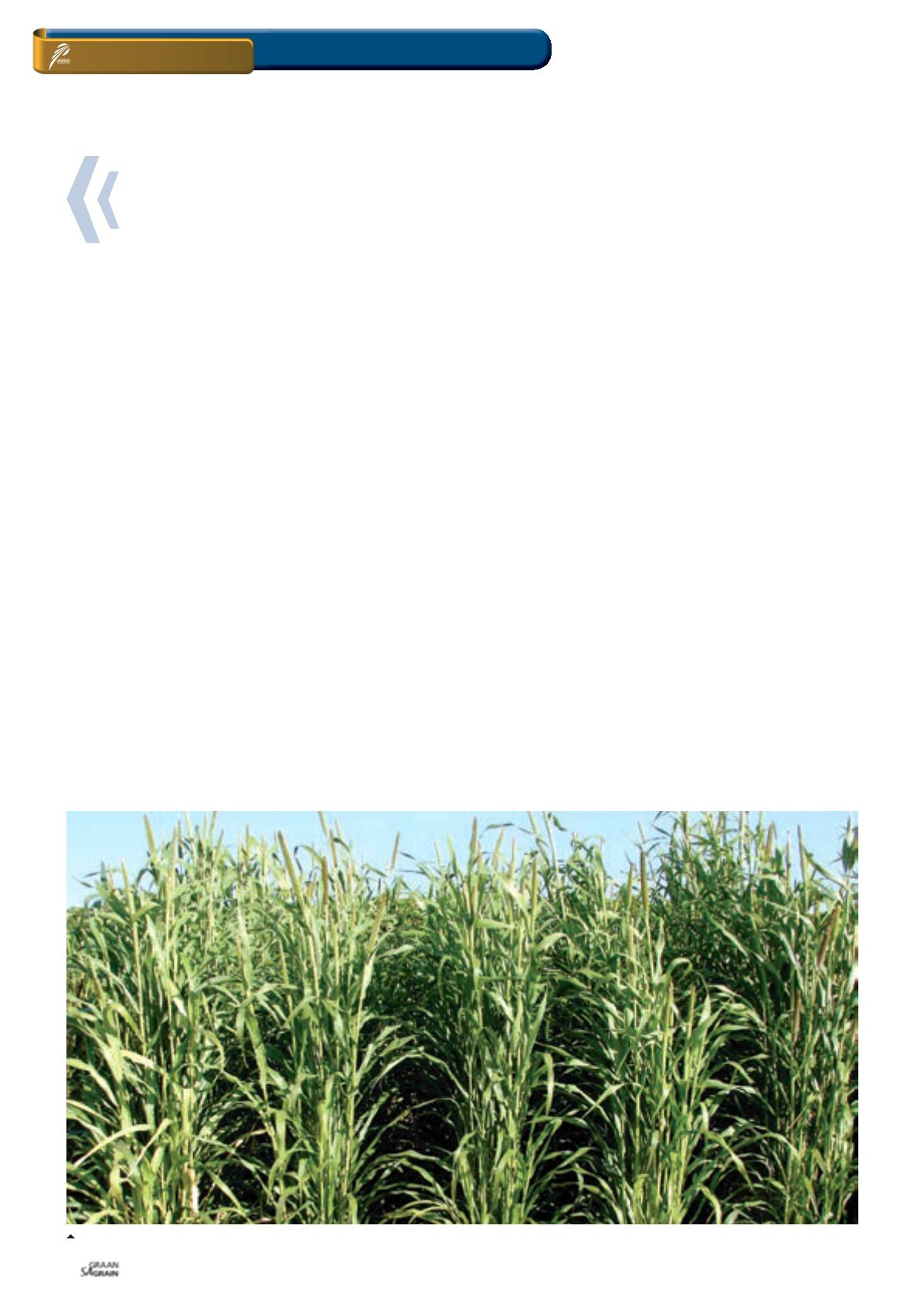

Planted in November, Nutrifeed has the highest production, followed
by Hypearl millet. If planted in December it has been shown that
Nutrifeed and Speedfeed has the highest production, while Milkstar
and Speedfeed did the best when planted in January.
In a lower rainfall season (± 750 mm) the Pearl millet produc-
tion values varied between 4,3 tons/ha - 5,6 tons/ha, if defoliated
monthly. There was no significant difference in production between
different cultivars and planting dates. During this season, Milkstar
and Hypearl millet were the early production cultivars, while Nutri-
feed and common babala will have a slower start, with a produc-
tion peak in February/March. Speedfeed peaked in the middle of
the growing season (end of January). Robertson, Botha and Ger-
ber (2009) reported a production of 8,4 tons/ha for Hypearl millet
tested on the Outeniqua Experimental farm (Western Cape), with a
long term average rainfall of 728 mm/year.
When planted in November for silage purposes, Hypearl millet
and Nutrifeed has shown that the highest DM production potential
to be ensiled (more than 30 tons/ha) can be achieved, followed by
Speedfeed and common babala (more than 17 tons/ha). However,
it is noted that cultivars such as Nutrifeed and Speedfeed can have
better DM potential for silage (more than 14 tons/ha) when planted
in December.
Planted as late as January, Speedfeed and Milkstar can produce
more than 13 tons/ha for ensiling. Under these conditions the same
cultivars can be used as foggage.
Management challenges
Fast growing annual pasture species such as Pearl millet, can have
a few management challenges. Often it is seen that the peak growth
rate of this species can result in the pasture growing faster than the
speed at which animals can graze and a sudden decrease in palat-
ability and quality is expected, resulting in a higher percentage of
plant material being selectively grazed.
The secondary effect of a too tall stand of Pearl millet is a much slow-
er regrowth rate once defoliated. There also exists the risk of nitrate
poisoning as a result of too high N-applications under sub-optimal
growing conditions. The pest control in millet production will entail
dealing with stinkbug, nematodes, chinch bug and birds.
Soil conservation and health benefits
A seasonal rotation cover crop such as Pearl millet can play an im-
perative role in improving soil structure, water infiltration and root
penetration.
Additional benefits include reduced soil crusting, soil erosion, runoff
and nutrient leaching. This species can also provide an affordable
on-site management option to enhance the inherent soil organic
matter through an extremely vigorous root system and secondly, it is
a suitable option to dry out very wet soils that are regularly irrigated
either in winter or summer.
Animal production aspects
From an animal production perspective, the forage quality that can
be obtained from good management of Pearl Millet is a crude protein
(CP) content of between 9% - 13% (unfertilised soils) and 13% - 24%
(fertilised soils), all depending on nitrogen fertilisation in conjunction
with sufficient moisture.
Total digestible nutrients of 60% - 70% and a dry matter digestibility
of 80% - 85% can be achieved. A grazing capacity of 1 - 1,5 LSUs/ha
is possible.
Increased crop diversification with babala
Babala is well-suited to be used as an annual cover crop in a crop
rotation system due to its strong root system and high biomass pro-
duction. There are many ways to insert babala as a cover crop into a
crop rotation to increase the diversity.
It can be established in a pure stand or in a mixture with other (cover)
crops or as a full-season crop to maximise its beneficial properties.
Babala can be used for a short period of time in the spring before the
cash crop, or later in the fall after a main crop has been harvested.
In South Africa, where crop rotations are mostly very tight, it is often
easier to insert a fall cover crop after the harvest of a short-season
CONSERVATION AGRICULTURE
ON FARM LEVEL
Conservation agriculture
Pearl millet in flower.
28
Desember 2014

















